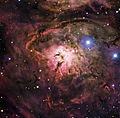Fayl:Lagoon Nebula.jpg

Kórip shıǵıw kólemi: 610 × 599 пиксел. Basqa rezolyutsiyalar: 244 × 240 пиксел | 489 × 480 пиксел | 782 × 768 пиксел | 1043 × 1024 пиксел | 1841 × 1808 пиксел.
Túp fayl (1841 × 1808 piksel, fayldıń ólshemi: 2,92 MB, MIME tipi: image/jpeg)
Fayl tariyxı
Aldın usı fayl qanday kóriniste bolǵanın kóriw ushin kún-ay/waqıt degendi basıń.
| Sáne/Waqıt | Miniatyurası | Ólshemleri | Paydalanıwshı | Pikir | |
|---|---|---|---|---|---|
| házirgi | 00:20, 2014 j. marttıń 4 |  | 1841 × 1808 (2,92 MB) | Lmbuga | Putting the nebula in the center of the image |
| 07:48, 2012 j. avgusttıń 9 |  | 2027 × 2064 (1,59 MB) | Fabian RRRR | higher resolution | |
| 07:32, 2010 j. apreldiń 22 |  | 1280 × 1303 (317 КБ) | EricHS211 | {{Information |Description={{en|1=Infrared view of the Cat’s Paw Nebula (NGC 6334) taken by VISTA. NGC 6334 is a vast region of star formation about 5500 light-years from Earth in the constellation of Scorpius. The whole gas cloud is about 50 light-year |
Fayldıń paydalanılıwı
Tómendegi 3 dana bette bul fayl paydalanılǵan:
Fayldı global paydalanıw
Tómendegi basqa wikilar bul fayldan paydalanadı:
- ady.wikipedia.org joybarında qollanıw
- alt.wikipedia.org joybarında qollanıw
- av.wikipedia.org joybarında qollanıw
- bn.wikipedia.org joybarında qollanıw
- cs.wikipedia.org joybarında qollanıw
- cv.wikipedia.org joybarında qollanıw
- de.wikipedia.org joybarında qollanıw
- en.wikipedia.org joybarında qollanıw
- et.wikipedia.org joybarında qollanıw
- fr.wikipedia.org joybarında qollanıw
- hu.wikipedia.org joybarında qollanıw
- kk.wikipedia.org joybarında qollanıw
- koi.wikipedia.org joybarında qollanıw
- ko.wikipedia.org joybarında qollanıw
- kv.wikipedia.org joybarında qollanıw
- lez.wikipedia.org joybarında qollanıw
- mdf.wikipedia.org joybarında qollanıw
- mg.wikipedia.org joybarında qollanıw
- mk.wikipedia.org joybarında qollanıw
- mrj.wikipedia.org joybarında qollanıw
- olo.wikipedia.org joybarında qollanıw
- os.wikipedia.org joybarında qollanıw
- pl.wikipedia.org joybarında qollanıw
- pt.wikipedia.org joybarında qollanıw
- ru.wikipedia.org joybarında qollanıw
- sah.wikipedia.org joybarında qollanıw
- sh.wikipedia.org joybarında qollanıw
- sk.wikipedia.org joybarında qollanıw
- sv.wikipedia.org joybarında qollanıw
- tt.wikipedia.org joybarında qollanıw
- udm.wikipedia.org joybarında qollanıw
Bul fayldıń kóbirek global paydalanıw bólimin kóriń.


